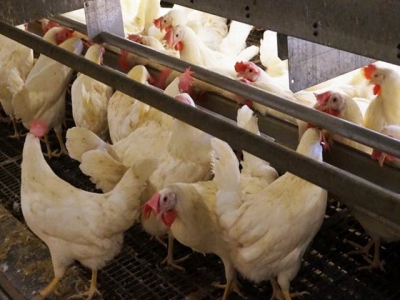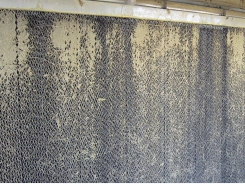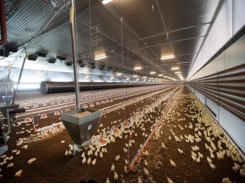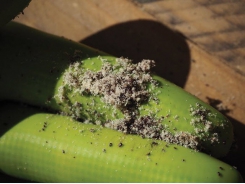Calculating additional resource needs in cage-free

Cage-free hens need considerably more feed than their conventionally raised counterparts, thanks to their increased mobility. | Austin Alonzo
Cage-free egg production requires additional manpower and feed, but exactly how much? Experts offer their estimates.
Along with greater attention to bird management and environmental settings, cage-free egg production simply demands greater resources than conventional production. Quantifying exactly how much extra labor and feed is needed, however, isn’t that simple.
Over the past few months, Egg Industry profiled best practices for rearing pullets, setting up the layer house and managing a cage-free flock. This installment will calculate the amount of additional resources needed for a successful operation and will review mistakes farmers commonly make and how to avoid them.
Evaluating labor differences
Removing birds from cages means more work is needed than in a traditional layer barn. The experts surveyed for this story didn’t reach a consensus about exactly how much more is needed. They did agree more labor is generally needed when the birds are being moved from the pullet house into the layer house. Additionally, flock management experience gained over time can reduce the amount of labor needed to manage the flock.
Patrick Stacklin, caged and cage-free layer building and equipment sales representative with poultry equipment distributor Northeast Agri Systems Inc., said about two to three times more labor is needed in a cage-free environment. Dr. Nestor Adriatico, director of technical services for Hendrix Genetics, said cage-free conditions generally require more skilled laborers with a strong understanding of best practices for poultry husbandry.
Dr. Anna Concollato, of FACCO’s poultry science technology department, said labor needs rise by more than 40 percent, to 0.52 man hours per hen from 0.35 man hours per hen in a caged environment. The cage-free environment generally calls for more time spent performing routine bird management and flock inspection. Over time, farm workers and farmers will develop better management skills, which can potentially reduce the amount of labor needed and boost productivity. She warned that improper pullet rearing techniques will lead to greater labor needs in the layer house.
Potters Poultry said the amount of labor needed will spike the first few weeks after the transition into the layer house. Additional workers are needed to collect floor eggs and establish proper nesting and roosting behaviors, as well as deal with any other problems. The effort put in during the weeks after the transition will pay off for the rest of the flock’s productive life. Conversely, if those issues are not properly addressed, more labor will be needed for the remainder of the cycle.
Salmet agreed, saying that cage-free operations do not necessarily require more labor than caged operations for the entire life of the flock. More labor is needed to ensure the successful introduction of the hens into the barn, but the establishment of good behaviors early on will pay off in the future.
Staff with a keen sense for animal husbandry are invaluable in a cage-free setting. Potters said the best workers will have a compassionate attitude toward the animals and be able to anticipate, and adequately respond to, any animal welfare challenges. The best workers will establish a methodical routine for daily management tasks.
The experts offered varied estimates of how many birds can be cared for by a single worker. With the right environmental conditions inside the house, Potters said one worker can handle 32,000 birds or more. Concollato said one worker can handle 40,000 birds in the layer house and as many as 120,000 birds in the pullet house. Adriatico said one worker can handle 50,000 birds in an aviary and Salmet said one can handle more than 50,000 birds, depending on the size and the layout of the barn. Snow said it takes 1.6 people working for about eight hours a day to handle a 50,000 bird flock. After the more demanding first few weeks of laying, Frank Luttels, sales manager for Volito, said one worker can handle as many as 60,000 birds.
Gauging additional feed and water needs
Cage-free hens are more active than their caged counterparts, so increased feed and nutrition needs are an inherent part of the transition. The experts offered differing explanations of just how much more feed is needed.
Concollato, as well as Luttels and Stacklin, said cage-free birds need about 5 to 10 percent more feed. Adriatico, and Potters, said the need can range from 10 to 15 percent more feed. The additional feed is needed to support increased mobility as well as maintained shell quality and egg laying performance.
To keep aggression in check and promote flock uniformity, the experts stressed providing adequate space for each bird to eat without competition and monitoring daily feed consumption. Without adequate space, only the most dominant bird will be able to feed. Potters recommended providing 4 linear inches for chain feeding, or 2 inches of circular feeding space, per bird.
Generally, Concollato said, cage-free flocks require more crude protein, TSAAs, methionine and lysine than caged hens. For economic reasons, farmers should work to provide an adequate amount of feed for cage-free flocks rather than a more nutritionally dense ration.
Cage-free birds do not necessarily need more water than caged birds, but housing systems need to provide enough drinker space to prevent competition promote flock uniformity. Generally, one nipple drinker is needed for every 10 birds.
EGG INDUSTRY’S CAGE-FREE MANAGEMENT SERIES
The U.S. egg industry is rapidly shifting to cage-free husbandry, and Egg Industry wants to help farmers gain essential bird management skills in order to ease the transition from caged to cage-free operations.
WATT Global Media interviewed and surveyed members and allies of the global egg industry to formulate a basic set of best practices for cage-free flock management that will be published through October. This story focuses on resource differences in cage-free farming.
This story was written with input from the following companies: Big Dutchman Inc., Hendrix Genetics BV, Jansen Poultry Equipment, Officine FACCO & C. Spa, Potter’s Poultry International, SALMET International GmbH, and Volito BV – now part of Chore-Time parent CTB Inc., Valco Companies Inc. and Northeast Agri Systems Inc.
Related news
Tools

Phối trộn thức ăn chăn nuôi

Pha dung dịch thủy canh

Định mức cho tôm ăn

Phối trộn phân bón NPK

Xác định tỷ lệ tôm sống

Chuyển đổi đơn vị phân bón

Xác định công suất sục khí

Chuyển đổi đơn vị tôm

Tính diện tích nhà kính

Tính thể tích ao




 Black soldier fly meal may boost growth, survival…
Black soldier fly meal may boost growth, survival…  Poultry red mites are Europe’s most costly poultry…
Poultry red mites are Europe’s most costly poultry…